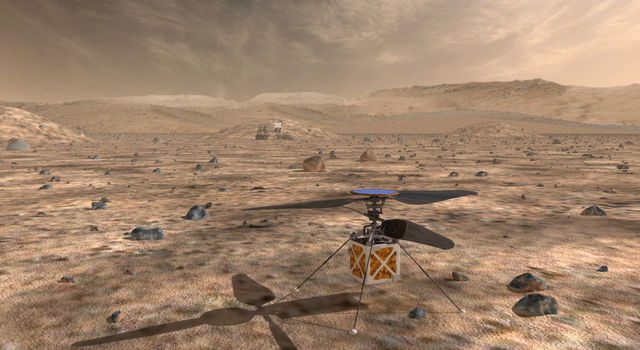January 24, 2015 – Jet Propulsion Laboratory (JPL) in Pasadena, California has a vacuum chamber where the thin Martian atmosphere can be replicated. This is the test bed for a proposed Martian helicopter that will be paired with future rover missions and act as a scout flying ahead of the rover’s path.
There are several challenges to building a helicopter to operate on Mars. One of the biggest is getting lift in the tenuous atmosphere of the planet. A second is making the helicopter both lightweight and durable to fly every day. The third is energy, producing enough for powered flight each day. The fourth is survivability, ensuring that the helicopter can take the diurnal heating and cooling that is far more extreme on Mars than here on Earth. And finally, the fifth is ensuring the helicopter has a landing system that is fail safe because no one will be able to pick it up and put it back together should it crash.
To get sufficient lift on Mars a helicopter needs its rotor to spin at a rate of 2,400 rotations per minute (rpm). Here on Earth a helicopter has the benefit of a much thicker atmosphere to help it achieve lift. Typically rotational speeds are around 400 to 500 rpm. Some larger helicopters with twin rotors can spin as low at 110 rpm. And tail rotors on Earth helicopters can spin up to 1,400 rpm. So our Mars helicopter will have to perform at rates considerably higher than here on our planet.
The current prototype weighs about 1 kilogram (2.2 pounds). The twin blades measure 1.1 meters (3.6 feet). The main body is the size of small cubic tissue dispenser. There is no tail rotor required in the twin-blade configuration.
How would a rover benefit from a companion helicopter? Each day the helicopter would fly ahead about a kilometer or more, approximately a 7 minute flight, and provide images of interest and a view of the terrain. From these images the JPL team could then plot the rover’s path potentially tripling the length of each daily drive.
Currently the view of what’s ahead on daily rover drives is limited to what its onboard hazmat cameras can see combined with satellite from Mars’ orbiters. The orbiters cannot provide the kind of detailed imaging that a helicopter flying less than 30 meters above the Martian surface delivers. These images could immediately identify interesting sampling points for the rover to navigate to. And in the future where the plan involves leaving caches of samples for pickup by subsequent rover missions the helicopter can provide accurate location details.
When will the helicopter fly on Mars? Possibly in 2020 with the next generation NASA Mars rover.
















